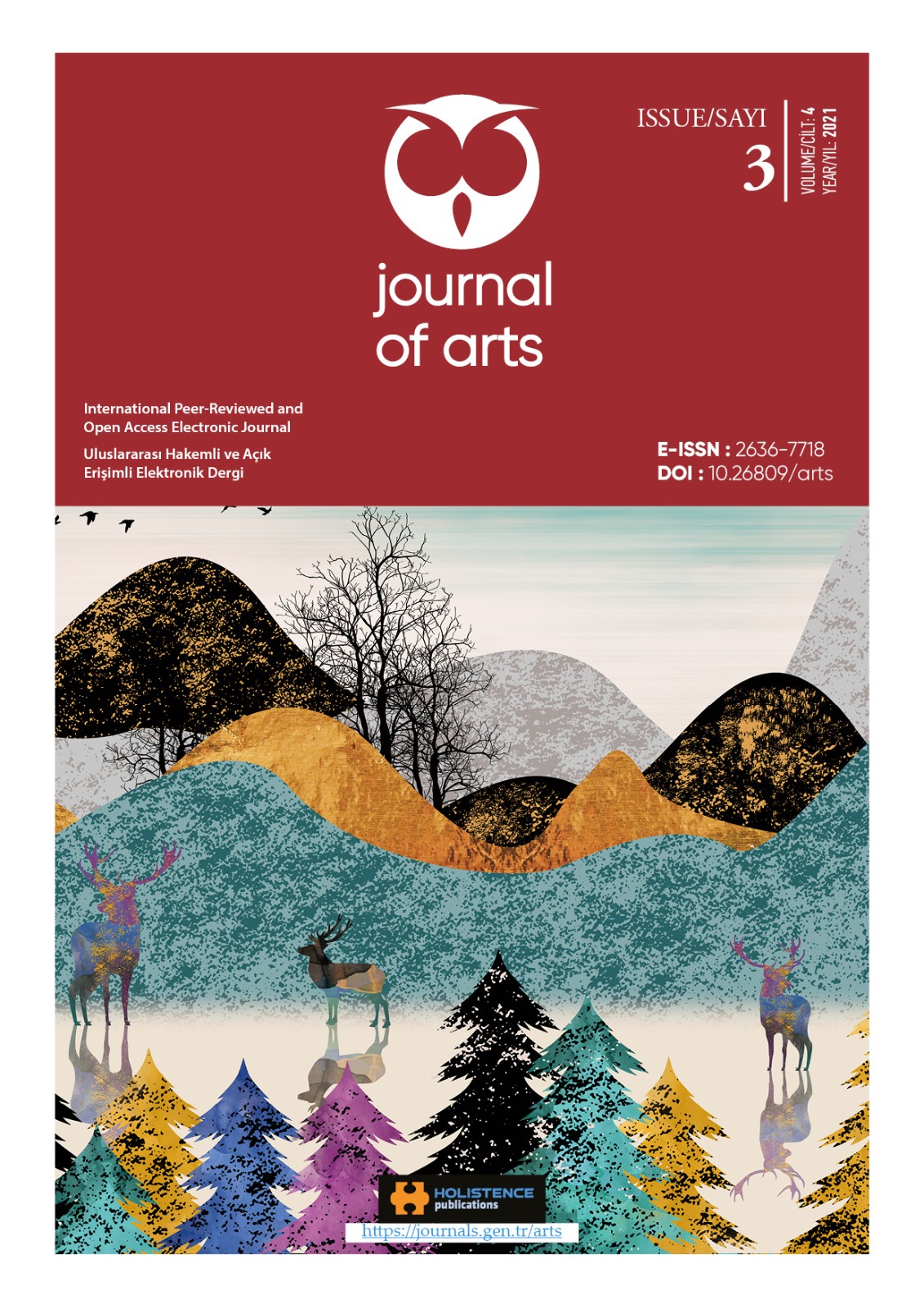The medness and laughter narrative of disruptive humor in art
DOI:
https://doi.org/10.31566/arts.4.3.03Keywords:
madness, laughter, allegory, Disruptive Humor., grtoteskAbstract
Madness and laughter in art’s destructive humorous expression encompass extraordinary, extreme, exorbitant, abnormal, satirical and alegorical representations, from Renaissance till today. In virtue of this purpose it’s seen that humor image lies outside the context of madness and the mad, sickness and the sick. The former is conveyed via allegorical and satirical forms that tells the truth. Laughter, on the other hand, is presented as pejorative properties that boasts over the faults and flaws of human rather than being a reaction against mere comedy. These two aformentioned elements have been contrarian satirical statements in artistic context, and communicated with debasing, critical descriptions revealing the vandal human mind. Therefore the resulting mockery both rejects and defames its subject. Such tokens of strong critique are observed to be in close relation with folklore and transform into impressive languages of allegory in the art sphere. The projection of madness and laughter images in art works, more clearly when the archive of the language they use is considered alongside satire, is both the harshest manifestation of human darkness in cosmic scale and the essence of the deeper roots of her inner journey, a historical perspective of civilization. The aforementioned factors that compose an insistent language from repetitive forms against the hierarchy of flaws endemic to human and her societies are statements strongly emphasizing the tragic aspect in persistent terms. In this vein the research will lean towards consciousness’ representations speaking of the essence, beyond the semantics of madness, the mad and her laughter. Together with the discussion detailed so far madness and laugther metaphors’ jagged comedic meanings and associated concepts will be explained. The scope of the methodology will be limited to the evaluation of madness’, the mad’s and (her) laugther’s destructive satirial perspectives and their evolution through time down from Renaissance, within the scope of related art and philosophy literature, including references to key art works when relevant.
Downloads
References
ANTMEN, A. (2008). Pala Şair?in bıyığı da Dali?den aşağı kalmıyor!, (çevrimiçi), Radikal. http://www.radikal.com.tr/yazarlar/ahu-antmen/pala-sairin-biyigi-da-daliden-asagi-kalmiyor-901213/ (Erişim Tarihi: 23.05.2021).
BAHTİN, M. (2005). Rabelais ve Dünyası. Çevirmen: Ç. Öztek. İstanbul: Ayrıntı Yayınları, 1. Baskı, ISBN: 975-539-431-1.
BAHTİN, M. (2017). Karnavaldan Romana. Çevirmen: C. Soydemir. İstanbul: Ayrıntı Yayınları, 3. Baskı, ISBN: 978-975-539-338-4.
BOYNE, R. (2009). Foucault ve Derida. Çevirmen: İ. Yılmaz. Ankara: BilgeSu Yayınları, 1. Baskı, ISBN: 978-9944-795-12-8.
BOZKURT, A. (2001). Bedenin Kahkahası Grotesk Gülünç. Hayalet Gemi (60). s. 33-34. İstanbul:Teknofil Teknoloji Tasarım.
BUCK-MORSS, S. (2010). Görmenin Diyelaktiği. Çevirmen: F. B. Aydar. İstanbul: Metis Yayınları, 1. Baskı, ISBN: 978-975-342-692-3.
CANTEK, L. (2003). Gülmenin Muhalif Duruşu, Folklor/Edebiyet 57, Sayı. 33. Cilt. 9. s. 57-71. Ankara: Başkent Matbaacılık.
ECO, U. (2009). Çirkinliğin Tarihi, Çevirmen: A.U. Ergün, Ö. Çelik, A. Uysal. İstanbul: Doğan Egmont Yayıncılık ve Yapımcılık, 4. Baskı, ISBN: 978-605-111-246-6
EAGLETON T. (2020). Mizah. Çevirmen: M. Pakdemir. İstanbul: Ayrıntı yayınları, 2. Baskı, ISBN: 978—605-314-419-9.
FOUCAULT, M. (2014). Sonsuza Giden Dil. Çevirmen: I. Ergüden. İstanbul: Ayrıntı Yayınları, 2. Basım, ISBN: 975-539-489-3.
FOUCAULT, M. (2011). Büyük Kapatma. Çevirmen: I. Ergüden, F. Keskin. İstanbul: Ayrıntı Yayınları, 3. Basım, ISBN: 975-539-285-8.
FOUCAULT, M. (2006). Deliliğin Tarihi. Çevirmen: M. A. Kılıçbay. Ankara: İmge Kitapevi, 4. Baskı, ISBN: 975-533-040-2.
GOMBICH, E. H. (2007). Sanatın Öyküsü. Çevirmen. E. Erduran – Ö. Erduran. İstanbul: Remzi Kitabevi, 7. Basım, ISBN: 978-975-14-0695-8.
MORREALL, J. (1997). Gülmeyi Ciddiye Almak. Çevirmen: K. Aysevener, Ş. Soyer. İstanbul: İris Yayınları, 1. Baskı, ISBN: 975-7909-05-X
ÖTGÜN, C. 3. Uluslararası Felsefe, Eğitim, Sanat ve Bilim Tarihi Sempozyumu, s. 67-69. 10-13 Ekim 2018 – Giresun.
PARVULESCU, A. (2017) Gülme, Bir Tutkuya Dair Notlar. Çevirmen: M. Doğan. İstanbul: Boğaziçi Üniversitesi Yayınları, 1. Baskı, ISBN: 978-605-4787-88-3.
RUSKIN, J. (2016). Belleğin Lambası. Seçme Yazılar, 1. Çevirmen: A. N. Tezel. İstanbul: Corpus yayınları, 1. Baskı, ISBN: 978-605-83809-1-2.
SANDERS, B. (2001). Kahkahanın Zaferi: Yıkıcı Tarih Olarak Gülme. Çevirmen: M. Doğan. İstanbul: Ayrıntı Yayınları, 1. Basım, ISBN: 975-539-211-4.
SASS, L. A. (2013). Delilik ve Modernizm. Çevirmen: E. Ürol. İstanbul: Alfa Yayıncılık. 1. Basım, ISBN: 978-605-106-824-4.
SCULL A. (2016). Uygarlık ve Delilik, Akıl Hastalığının Kültürel Tarihi. Çevirmen: N. Elhüseyni.. İstanbul: Yapı Kredi Yayınları, 1. Baskı, ISBN: 978-975-08-3727-2.
SMADJA E. (2013). Gülmek. Çevirmen: S. N. Arım. İstanbul: Bağlam Yayınları, 1. Baskı, ISBN: 978-605-5809-80-5.
STAROBINSKI, J. (2012). Özgürlüğün İcadı ve Aklın Ablemleri. Çevirmen: H. Bayrı. İstanbul: Metis Yayınları, 1. Basım, ISBN: 978-975-342-861-3.
ZISS, A. (2009). Estetik (gerçekliği sanatsal özümsemenin bilimi). Çevirmen: Y. Şahan. İstanbul: Hoyalbaz Yayıncılık, 1. Baskı, ISBN: 978-605-60600-6-9.
Additional Files
Published
How to Cite
Issue
Section
License
Copyright (c) 2021 Holistence Publications

This work is licensed under a Creative Commons Attribution 4.0 International License.
When the article is accepted for publication in the Journal of Arts, authors transfer all copyright in the article to the Rating Academy Ar-Ge Yazılım Yayıncılık Eğitim Danışmanlık ve Organizasyon Ticaret Ltd. Şti.The authors reserve all proprietary right other than copyright, such as patent rights.
Everyone who is listed as an author in this article should have made a substantial, direct, intellectual contribution to the work and should take public responsibility for it.
This paper contains works that have not previously published or not under consideration for publication in other journals.










